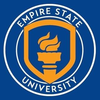
Overview
Founded in 1971, the Empire State University is a non-profit public higher education institution located in the suburban setting of the large town of Saratoga Springs (population range of 10,000-49,999 inhabitants), New York. Officially accredited by the Middle States Commission on Higher Education, Empire State University (ESU) is a medium sized (uniRank enrollment range: 9,000-9,999 students) coeducational US higher education institution. Empire State University (ESU) offers courses and programs leading to officially recognized higher education degrees such as pre-bachelor's degrees (i.e. certificates, diplomas, associate or foundation), bachelor's degrees, master's degrees and doctorate degrees in several areas of study. See the uniRank degree levels and areas of study table below for further details. International students are welcome to apply for enrollment. ESU also provides several academic and non-academic facilities and services to students including a library, financial aids and/or scholarships, study abroad and exchange programs, online courses and distance learning opportunities, as well as administrative services.
University Snapshot
Control
![]() public
public
Entity
![]() non-profit
non-profit
Size
![]() medium sized
medium sized
Selectivity
![]() not available
not available
University Identity
| Name | Empire State University |
|---|---|
| Name (English) | |
| Name (Non Latin) | |
| Acronym | ESU |
| Founded | 1971 |
| Motto | |
| Colours | |
| Mascot | |
| Screenshot |  |
| Video Presentation |
University Location
| Address | 2 Union Avenue Saratoga Springs 12866-4391 New York United States |
|---|---|
| Location Map and Satellite View | |
| (518) 587 2100 | |
| (518) 587 5448 | |
| Other locations |





Social Media
Introduction
Social media can be a powerful tool for Universities to communicate with current students, alumni, faculty, staff and the wider community. But how can social media be important for prospective students? Read our article about the importance of Social Media for universities and prospective students to learn more.
Social Media
uniRank publishes brief reviews, rankings and metrics for some of Empire State University's social media channels as a starting point for comparison and as an additional selection tool for potential applicants.
Empire State University's Facebook page review
Empire State University's X page review
Empire State University's Youtube page review
Empire State University's Instagram page review
Empire State University's official LinkedIn profile
n.a.